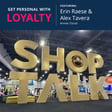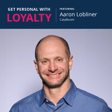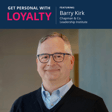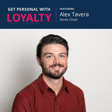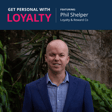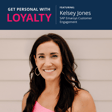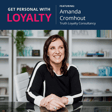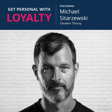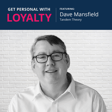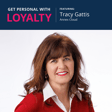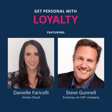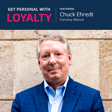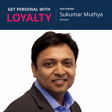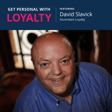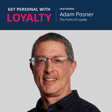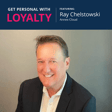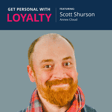Become a Creator today!Start creating today - Share your story with the world!
Start for free
00:00:00
00:00:01

Mastering Personalized Marketing with Stephen Stone
CRM and customer loyalty expert, Stephen Stone, has worked for mega brands—including Bank of America, Toys "R" Us, Bath and Body Works, and Lane Bryant. Join us for this episode to gain his unique insights on how to align personalization efforts with business objectives, why you should always be testing, why a roadmap is essential for growth and improvement, and the importance of company-wide support and collaboration.
Transcript
Introduction to 'Get Personal with Loyalty'
00:00:10
Speaker
Get Personal with Loyalty, where we're discussing using loyalty to deliver personalized, relevant customer experiences. Hello, everybody. Welcome to another episode of Get Personal with Loyalty. I'm Erin Raice, your host, and today I'm here with Steve Stone. Steve, hi. Hello. How are you today?
00:00:30
Speaker
I'm well, I'm so excited to have you on the podcast today. As we were planning on this whole thing, thinking back of how long we've known each other, we've been in this space longer than probably either of us want to.
00:00:44
Speaker
Exactly. I was liking it here when you told me your son was now 16. Cause I think we first started talking. He was probably four or five. So yeah, no, it's definitely, it's been wild, but yeah, no, I'm super happy to be joining you today. It's not every day that I get the chance to kind of geek out on this. And I love to geek out on this stuff. I'm so yeah, let's hit it.
00:01:04
Speaker
Great. Well, why don't we start with you giving your background? As we just mentioned, you've been in the space a long
Steve Stone's Professional Background
00:01:10
Speaker
time. You've been at a lot of really amazing retailers, running CRM and loyalty for them. And so tell us how you got into this and why you're staying in it. Yeah. So if I take it all the way back, I got my MBA at University of Arizona, bear down all my alum friends, but really so starting off actually in financial services, believe it or not.
00:01:28
Speaker
I'm doing retention activation campaigns for Bank of America credit cards. And dating myself, this was when our primary channels were direct mail and telemarketing. So before the rise of email, I did a lot of those campaigns, worked a lot with the in-house retention unit, things like that. That's where I got my first baby taste of loyalty. I got a chance to work with a group of people on putting together a pilot program for Bank of America.
00:01:55
Speaker
that looked
Innovations at Toys R Us
00:01:56
Speaker
at, Hey, could we come up with something that would reward people for all of the different potential accounts that they would have with the bank? So how do you give somebody points for having a mortgage or an auto loan beyond just a transactional with a credit card or a debit card?
00:02:11
Speaker
I got to work on that pile a little bit. So that kind of gave me my first taste, but really realize financial services is a great background for like, how do you do things and financial discipline and all those things. But it missed a lot of the marketing elements. So back in the early 2000s, all the retailers wanted to do CRM. None of them were really doing it well because it was kind of the Wild West.
00:02:34
Speaker
So I left Financial Services and went to Toys R Us of all places, which was yeah, about as absolutely polar opposite as you could get from Financial Services. So did a lot of their CRM stuff, their direct mail. Again, this was another place where I got an early taste of loyalty. So had the challenge to come up with a program at Toys R Us at the time. Everybody knew about Toys R Us for holiday and everything else. The second main reason why you would go to Toys R Us was around perfect.
00:03:00
Speaker
The problem we had was we had amazing database on like information about the family of the parents. So 65 million customers, whatever it was, but didn't have reliable information about the kids. And so we came up with this concept and created this program called Jeffrey's birthday club, which essentially.
00:03:18
Speaker
filled
Developing Multi-Tender Loyalty Programs
00:03:19
Speaker
in the gaps. So we got, we didn't use the term back then, but it's absolutely what it was. Zero party data from the parents. Oh, I've got three kids. Here are their names. Here are their ages. Here are their genders. And so it gave us the opportunity to build our marketing engine. So now I can market to somebody around a birthday or something else and be able to personalize that message because I might market to you differently if you had a 12 year old girl versus a six year old boy.
00:03:47
Speaker
And so again, great learning process, kind of everything from that removed on. So I've done CRM for Bath and Body Works, CRM and Loyalty for Build a Bear. But my first real like hardcore loyalty gig was hired and expressed to basically build their first multi-tender program.
00:04:05
Speaker
So they had an old private label credit program, but really it was only 20 ish percent of their customer base who had the card. So that means the vast majority of their customers, other than sending them direct mails or emails, they didn't really have a lot of the offerings for.
00:04:20
Speaker
So came in and really designed that program, built it out, launched it, ran it. So tons of
Challenges in CRM and Loyalty Integration
00:04:28
Speaker
learning, great opportunity. You know, some of the things that we were able to do with that brand was it was a lot of fun and a lot of learning. Took that, moved on to American Eagle, same concept. They actually had two different programs.
00:04:40
Speaker
They had a credit card program and then they had an old discount program. So both of which they wanted to sunset and come up with multi-tender. They had a pilot program already in market that wasn't working, they weren't happy with. So basically brought me in to straighten out all that mess. So how do you take three different loyalty providers that they were working with and streamline that process? How do you sunset kind of two programs and fold them into a new multi-tender program?
00:05:10
Speaker
How do you make sure that it's set up where it works for both the American Eagle and the Airy brands? So being able to do all that. But then I also had responsibility for their Direct Rail CRM activities as well. Got the ability to start to, how do you integrate those things together?
00:05:26
Speaker
How do you start thinking about those two channels or those two programs together as opposed to running them in silos? Because personally, I think there's so much potential and so much power when you start to unlock that. And so again, that's where I was able to take that into my next opportunity. So like with Lane Bryant was so similar. They had an old program, wanted a multi-tender program, had two different brands, wanted separate programs for those two different brands.
00:05:53
Speaker
So again, built all of that, launched all that, but then also like American Eagle had a responsibility for all the own channel marketing as well. So think direct mail, email, SMS, push up notifications. And so again, have the ability to start tinkering with how do you start to link all of those things together and really unlock the power and the potential of both programs and build it all up together.
Importance of Organizational Support
00:06:17
Speaker
Wow. Wow. I knew you had a lot of experience, but you really do. I know we had a whole plan of how we wanted to take this conversation, but in listening to you, you go through all of that. I think where I would really love to dig in is the experiences around American Eagle and Lane Bryant, where you have both sides of this customer experience from a marketing perspective, because they know as a consumer.
00:06:44
Speaker
I still see separate communication all the time. And it's so, as we talk about personalization and we talk about bringing things together and then we, as consumers are experiencing these disparate marketing, obviously everybody wants to get to one.
00:07:01
Speaker
But i suspect they're the devil's in the detail and maybe the technology and how do you bring it all together and how do you do it. So perhaps you can talk to us a little bit about what is that entail me what are some of the challenges and what are some of the things that you learned that you be our audience could learn from.
00:07:18
Speaker
Yeah, that is such a tangled, but interesting topic. Really nothing else to do, but again, so some of the biggest challenges with that are really there's the data element. What information do you have? And there's the IT element. Do we have the ability to share that data between the platforms? So depending on how your stuff is set up.
00:07:40
Speaker
Does that data easily move from one to the other? Are those platforms integrated? How does all that work? Is it integrated across all of your channels? And so can you do an email, but not an SMS? Can you do it in direct mail? How does it work differently? That's a huge consideration. And then as you think about the actual execution of it, a lot of organizations are still in the mentality of counting messages.
00:08:08
Speaker
And so you get into that argument of, Oh, if we don't send them the big branded message because we're sending them this other thing, or if we're changing what that message is, because we're tailoring like, how are they going to know that we're selling this
Testing and Iterating Loyalty Programs
00:08:25
Speaker
thing? You have to figure out for your own organization.
00:08:28
Speaker
How do you start to weave those things together? And it's not every message, every time you have to start to think through where are the places where it makes sense? Where do we start? What do we learn? How do we build from there? And how do you pull all of that apart? Or again, talking organizationally, that's also where you have to, like, how do you start to build your data sets and your credibility with the organization? Because there have been times in my past we'll say,
00:08:56
Speaker
where we've run these campaigns, where we've done some personalization or we've done some things where, Oh, Hey, they didn't get the main branded message for the day because they got this other message earlier. And because of our collision rules, they didn't get sent this other thing.
00:09:13
Speaker
And then you get that dreaded message from your leadership. I didn't get this morning's email. Is there a problem? Did the emails go out? What happened? And suddenly you're the cause of the downfall of Western civilization because they didn't get what they were expecting to get. And so it becomes, how do you build all of that? How do you start to build that trust? How do you communicate to your leaders when you're doing things, why you're doing it, what you've learned from it, what you're doing next?
00:09:41
Speaker
There's so much to dig into on that, but yeah, you really just have to pick your place and start.
00:09:50
Speaker
As you were talking, I was thinking about all of, obviously all of it. And the point about the message of the day really, I think everybody can relate to that. Where does the direction come from? And is there guidance where you were sitting within the organization? Were you able to create a roadmap for what the customer experience was going to be? Or were there other forces that were making it too challenging to do it? So this brand message of the day.
00:10:20
Speaker
It doesn't sound very personal and self-serving. How do you change that? It's so organizationally
Big L vs Little L Loyalty
00:10:29
Speaker
dependent. I've had different levels of success in different organizations. I've had it reacted to differently based on what the business situation was at the time.
00:10:45
Speaker
And so it's one of those things where, you know, I hate to say it and I don't mean this in a negative way, but it's a little like Sisyphus and it just has to keep pushing that boulder up the hill. You know, sometimes it's going to roll back, but you start pushing it again and the next time you get it, maybe it's a little further and you really have to approach it as a constant evolution.
00:11:04
Speaker
because, Hey, what's working today may not work tomorrow. And so you can't sit back. So you have to keep working at it and figuring out how are the ways that we test this in controlled manners, in measurable and readable manners. So I can come back to the organization and say, Hey, here's what we did. Here's what we learned. And you have to be truthful and honest. Like you can't spend that stuff as you're reporting it back.
00:11:29
Speaker
Because if you start to spin it, then they start to think, Oh, like things are great. Like we should be seeing more results. And if the results weren't there, you've kind of set yourself up. And so you basically have to say, Hey, here's what we learned. It was good or it was bad. Here's what we took from it. Here's what we're going to do next time.
00:11:48
Speaker
And keep that open communication and that honest communication and just continue to dig at it. You also have to look at and think through, are we doing the things that are meaningful to the program? So everybody starts with kind of this base of these basic tenants of here's what our loyalty program is going to do.
00:12:11
Speaker
We're going to increase transactions, increase AOV, whatever it is, having those ideas of this is what our program is meant to do and how it's going to drive the business.
00:12:22
Speaker
Now, as you start to look at your communication efforts and your personalization efforts, are you testing and doing things that ladder back to those core tenants of your program? Because if not, then you're just distracting yourselves and your customers. And so it's those types of things that you have to keep in mind when you build out these tests and you build out these plans on, Hey, we want to, we want to do personalization because it's, it's the hot topic, but
00:12:49
Speaker
Now you need to get beyond that. Why are
Starting a Loyalty Journey
00:12:52
Speaker
we doing it? How does this make our program better? How does this make our brand better and start to think through those elements? And then you can start to dig into the more of the what's.
00:13:05
Speaker
So what can we do? What do we want to do? How do those things intersect? Because as you start to look at it, you're like, Hey, I may want to do all of these different things, but wow, I don't have the data that supports that. So I can't do all those things.
00:13:21
Speaker
Or you may like, Hey, we want to do all of these different things, but Oh, you know what? Our IT infrastructure isn't there. We can't do that level of personalization or we don't have the bandwidth in the marketing operations group to be able to create 57 versions of today's email on all these different things that we want to personalize. And so you have to start with those again, start with your goals. How does it ladder back?
00:13:48
Speaker
And then start to get into the, okay, how can I start to pick away at some of these things? How can I start to learn little pieces that are going to leave me the next thing and leave me the next thing? Like it's almost like building a mini loyalty program. You have to have that
Navigating Executive Buy-In
00:14:04
Speaker
roadmap of, Hey, here's what we want to get to. Here's where we're going to start. And you know what, we're going to figure it out along and how do we build and grow. And if to take this next step, we're going to need to invest in new technology.
00:14:16
Speaker
To get to this next step, we might need to pick up a new or different partner or whatever it is and really sort of think through it and map that out. And then it's literally just the test and learn as you grow and build.
00:14:29
Speaker
One of the things that you were talking about your program and your program's North Star of increasing transactions and increasing AOV in my mind went to, okay, it's program, but it's really your overall business, right? The program is a vehicle or enabler to drive more revenue, to drive more overall transactions for the business. And so you need to be able to think of it in the macro sense as well as more of the micro sense of the program metrics as well.
00:14:59
Speaker
So if you've done your homework initially, because you should have done a lot of these same steps when you built your program.
00:15:06
Speaker
You should have said and defined, here's what this program is meant to do to drive these business results. And that should be sound. Now, again, that's something that you have to continue to turn, to tune and to monitor as your program grows, as your brain changes, you know, making sure that you keep those things aligned. And when you need to make changes in the program because of changes in the brain or whatever. But if you've done that work.
00:15:31
Speaker
then as you look at these personalization things, and if you go through that same exercise of if these are the tenets of the loyalty program, which should ladder back to the tenets of the brand, then I should be fairly solid in terms of I'm doing the right things. Now, to the point you made earlier, yes, the devil is 100% in the details because what you'll start to run into in the moment is
00:16:00
Speaker
You'll start to hear things from the organization around, Oh, we can't do this loyalty thing now because we've got this other like promotion going on. And so that's where you start to get some of those friction points around the bigger business versus the loyalty business and how those things work together or don't work together or where it makes sense earlier on or with smaller programs, when it's only.
00:16:25
Speaker
30, 40% of the business, whatever it is, yes, you have to have a little bit more consideration. But when you start to get to some of these programs that are critical mass where your loyalty members are 70, 80, 90% of your business, that's the time where organizations need to start thinking about it. And it's different for a lot of them and it's uncomfortable because again, forever take it back to our early days in loyalty.
00:16:52
Speaker
And loyalty was always the last kid picked or you're involved doing your own thing. Oh yeah. No, that's loyalty. We're just using that as a way to get some email addresses from customers or a way to be able to identify customers at POS so we can do other things.
00:17:08
Speaker
But over time, how that's grown and how that's changed. And now loyalty is starting to take a little bit more of a central position with some of these organizations, because as these programs have blown up, it's now the majority of your customers that you're talking to when you're sending out loyalty communications.
00:17:28
Speaker
So it starts to make sense of, hey, if we've already got things built into our program in terms of customer incentives, customer communications, then maybe we should be putting some emphasis and focus on those.
00:17:45
Speaker
and think about the other promotional elements that we do on how they enhance that or work with that, as opposed to these two opposing forces that are always butting heads because you're worried about the margin over the weekend.
00:18:00
Speaker
And so that's where some of that change is going to have to occur. And some of that is going to be on the loyalty program managers. And again, building your data sets, building your business cases or making your partners in the organization and making sure that they understand how this is building and growing.
00:18:17
Speaker
But then there are also those times where there are some non-negotiables in an organization and certain events or certain other things that like, yep, this thing takes precedence. I get it. So then you start to think, how can we enhance and support that with the loyalty program? And so how you play those together and always thinking, when does which one take the priority versus the other? And when does that flip?
00:18:41
Speaker
And I have to imagine that come from essentially the more support you have from the top, then the more hopefully cohesive then the communication or the support of loyalty is. Yes and no. I think you have to have some degree of support around the program from the top.
00:19:02
Speaker
at the same time, making those partnerships and those relationships across the organization are so crucial and critical on how you do some of that stuff. Because one of the biggest things that you want to make sure that never happens is if you're going into an executive review and pitching a new idea.
00:19:25
Speaker
The last thing that you want to happen is to have it delayed or just killed outright in that meeting by another C-suite exec because they didn't understand it or didn't know what it was. Like you need to be partnering with their teams and getting those head nods in advance. And so we are walking in and yes, you still have to convince people and pitch your idea.
00:19:49
Speaker
But yeah, I sure do want that finance VP nodding his head up and down as I'm speaking. Or I sure do want the CMO or the creative director or the ops director shaking her head up and down. Oh yeah. No, we can absolutely do this. We've got it planned out. Like how we'll support it. Like you, you want to build that team base where, Hey, I'm vetting ideas through them. And they're telling me, yeah, we can do it or we can't do it. Or we can do this, but here's what we're going to need.
00:20:17
Speaker
And then so you make sure that you've got those solid plans before you start to present. Cause if you walk in and present something and they don't understand it and they kill it dead, or you walk in and present something that then you go back and talk to your partners and they're like, there's no way we're ever going to be able to deliver this. Like you're out of your bird. Like, why did you pitch that idea?
00:20:36
Speaker
Both are bad situations. And so again, that's where you've got to do the work. You've got to work with your partners. You've got to come up with these plans and these ideas and these roadmaps and vet them out and then take it up. But to your point, if you've got somebody at the top who just doesn't believe in it, there's only so much you're going to be able to do. And that's where
Evolving Perceptions of Loyalty Programs
00:20:57
Speaker
again, you just, you're going to have to whittle away and you're going to have to again, build your data, build your partners and just keep chipping away where you can.
00:21:06
Speaker
And to your point earlier, it seems like more and more organizations today are getting that support. More and more organizations understand the power that loyalty can bring if done well. I would say probably close to 10 years ago, we were hearing a lot of people say, no, I don't want loyalty because it means discounts. Or I don't want it because I can't talk to my board or my CFO because it means liability. And.
00:21:32
Speaker
Frankly, not hearing a lot of those conversations anymore, hearing much more around how loyalty is a way to enable all of the other things that the organization wants to get done. And we're hearing more and more stories. It used to be also was the one that was the.
00:21:49
Speaker
out there in the outlier where 98% of all transactions were loyalty transactions. And those of us that know the story know that they did that as a business decision so they could become moved from a discount or to a full price retailer, which is very unique in its own right. But yet.
00:22:05
Speaker
They're not alone now. We're hearing more and more companies talk about maybe not the 98%, but 80%, 88% or so of all transactions or loyalty transactions. So you does feel like we're finally getting our day in the sun.
00:22:20
Speaker
It does. And it's been a long time coming and I'm not going to out anybody, but I can remember the first time after years of pitching ideas and getting the, Oh, we can't do this because we've got this thing going on. I remember walking into a meeting, I won't say what company and we're going through like the promotional calendar and then having the CEO say, Oh, what if we did a loyalty event on this weekend?
00:22:47
Speaker
And I generally try to keep composed in meetings, but I am fairly certain that I made a face. And just because I couldn't, I couldn't believe that God, it's finally happening. They get it. They're ready to engage. Okay, then let's rock. Yes. Let's get, we will actually do a loyalty event that weekend. Let's go. And so yeah, it's, that is thankfully a tide
Measuring and Analyzing Loyalty Campaigns
00:23:09
Speaker
that is turning.
00:23:10
Speaker
Or I would say at this point it has turned out not everybody's there, not everybody's there in every situation. But oh yeah, if I look back 10 years or so, just the difference in attitudes within the organization and the more prominence of loyalty programs and loyalty professionals are taking in organizations, it's night and day.
00:23:29
Speaker
Something you said to me a long time ago, I've used it many times. You probably don't know this, but you said something to me. It was a little too big for a long time. It's expensive. I think it was really the long time that really hit me and I've used over and over again. And it's like.
00:23:45
Speaker
But it doesn't have to take a long time because they remembered it was like, what do you mean? I guess then it was like, it takes a long time to set up. It takes a long time to establish a program. It takes a long time to get a promotion set up and all those kinds of things. It doesn't have to take long. If you have that customer data, you should be able to go out and run a promotion right away to those folks and be able to actually see the impact.
00:24:10
Speaker
I think what it was that I never fully understood it back then was kind of the nature of the beast. Technology just wasn't where it needed to be at that point, perhaps. And I'll let you explain, cause maybe I still have it wrong. But it always seemed like, well, not with the right technology, as soon as you've got it moving, it should be the one initiative where you've got all these levers to pull. So you really can't make an impact.
00:24:35
Speaker
Yeah. So that was a long time ago and so much has changed, but really I think you absolutely have part of that nailed on. Where back then, that even if you had an established program, some of the hurdles and the hoops that you had to go through to launch a campaign were painful.
00:24:56
Speaker
or lack of data or, Oh, the data's over here. So we're going to have to download it from this database and then put it over here so we can do this thing to it. And then we're going to have to load it up into the engine. That's actually going to execute it. It was painful. Um, but then I would also say, again, that was also organizationally. It was painful because like we just talked about a lot of leaders weren't there yet.
00:25:21
Speaker
Or they didn't understand it or the program wasn't big enough so it didn't garner their attention or their focus. And so it was all these little things that kind of led up to that. But then there's also the concept of.
00:25:34
Speaker
building brand loyalty, big L loyalty. That is what absolutely can take time and it needs attention and how you build that because, Oh yeah, you can launch campaigns and hit them with quick things. And is it the right things? Are you starting off your relationship with the customer by coupon training them?
00:25:57
Speaker
And so you're not really building loyalty in the brand. Are you building loyalty in the discount or in the program? So there still are some of those elements that when you think of that big L picture, it does take time, but in terms of executing and starting to build that.
00:26:15
Speaker
That has been significantly cut, which then in turn does help cut how long it takes to build up some of those other things because there's so much more I can do and I can do it so much smarter now than I was able to do it 10 years ago. And how that works together and how that fits together and how that builds. But yes, it is such a better place today with better tools, better partners, better data, a more focused from the organization. And so a lot of those pain points are gone.
00:26:46
Speaker
to get to here. And I also love that you brought up the big L. One of the things I did want to talk to you about is when we were prepping, you mentioned little L loyalty being supported by big L loyalty. What does exactly that mean and how do they weave together both?
00:27:03
Speaker
Yeah. So for me, really what that means or how that kind of works in my head is that idea of it's what we've been talking about. And how do you break down the silos? And so like, I can run a loyalty program and it's off doing its own thing. And I can run a brand program, CRM database market performance, or whatever we'll call it. And I can run that and it's off doing its own thing and they're doing their own things. And you know what?
00:27:29
Speaker
If you're not mindful of both of those silos, they're going to start colliding with one another. You're going to have messages that don't go out because, Oh, this brand did the email just went and it trumped this loyalty email that with 20 minutes afterwards, because we've got these collision rules that you can only get one email every few hours or whatever it is. Or you could be sending like, Oh, this talked about one thing. This talked about something completely different and the two don't match and they don't.
00:27:59
Speaker
build on each other and they're conflicting messages to the customer. And so yeah, like individually I can ladder things up, but wow, if I get smarter about how I weave those things together, if I start to think about how does one compliment the other, how does one build the other, that's where you start to unlock some of those exponential gains. That's where you get to the place where, Hey, you know what one plus one equals four.
00:28:25
Speaker
And so really to me, like that's what that concept is of how do you smartly start to weave those things together and build a more cohesive communication stream, build a more cohesive brand message around all of these elements and not just building this one thing or that one thing or trying to build those two things together. Cause now you're splitting your thoughts or splitting your resources where there's really just a lot of power to unlock.
00:28:53
Speaker
when you combine them and do it smartly. I agree. Is there like a particular framework or how do you approach this? How does somebody who maybe just be getting started in this, where do they go? It really, for me, there's a few different kind of starting points. So like I said, as you're starting down this journey, I think one of the most important things you need to do.
00:29:20
Speaker
is just like when you built your program initially.
00:29:25
Speaker
What do we want this to do? Be very focused and very clear about, here's the expectation and it can't be, this is the trap that again, people are getting better about this. This is a trap that you always used to run into. In building a loyalty program, you would ask an executive, what do you want this program to do? And you get the canned answer. Oh, we want to increase sales and we want to increase our retention and this and that. Yeah, I get that. But that's where you start to get into the.
00:29:53
Speaker
But how are we going to do it? What are the levers that are going to help us do that, that we can affect? Because yeah, there are lots of different ways to build annual sales. But what are the things that we can meaningfully impact? And then how do we build that program, whether it be our loyalty program or whether we start to think of this personalization journey and some of these other things.
00:30:19
Speaker
Literally, what are the goals that we want this to do? And you really have to start with that foundation because that becomes your lens on is this tactic that we're thinking about, does it make sense or not? Does it ladder back to those core principles or not? Because if it doesn't, I don't know if we should be doing it or I don't know if it should be the first thing on our list.
00:30:42
Speaker
Because some of those things might be exploratory, but focus on what matters most first. And then you could play in the margins and start to learn. And so it's really, you have to start with that. You have to start with that foundation and be crystal clear on what you're hoping to accomplish and what you're hoping to execute.
00:31:01
Speaker
And then from there, it is test. Always be learning and thinking through, so setting these things up, Hey, you know what, here's what we're going to do. And again, building that business case, here's our expected results. And looking at the variance analysis and say, Hey, you know what, if it performs 10% better or 10% worse, and then you have to look at it from a business case perspective, am I comfortable with that range?
00:31:27
Speaker
Cause there could be something where, Hey, in order to do this, like we need to have some investment or we need to do this or that. And if it ends up on this low end of the range financially, it doesn't make sense. Are we comfortable with that risk or not? And so again, that's where your business case comes in. That's where your finance partner and everyone else is coming to that alignment. And then as you start executing, it's making sure that you're setting up where again, you can always read and you can always learn.
00:31:55
Speaker
And as you think about testing and measurement and all of those things, it really comes down to.
00:32:05
Speaker
How am I setting this up? What am I trying to read? And so obviously, you know, the greatest way to do it are one of the best ways to get the most comfortable read. Hey, can I set up a whole match holdout control groups? So let's say I've got an audience of 200,000 people and we're going to do this campaign against them. And you know what? I'm going to slice out a chunk.
00:32:27
Speaker
10,000, 20,000, whatever is appropriate for how you measure. And hey, they should be getting this, but we're not going to send it to them. And then I can read both of those groups and I can say, Hey, you know what, for the people who got this thing, here's how they performed for the people who didn't get it. Here's how they performed. It worked. It didn't work. Here's what we learned. And so that's one of the, one of the great ways to be able to do it.
00:32:52
Speaker
It doesn't work in every situation. You can't always set up this match control group. You have to measure what you can. You look at other things like, Hey, we run something like this before.
Continuous Learning in Loyalty Programs
00:33:02
Speaker
Maybe it's not this exact thing, but it's a similar discount amount or a similar event and try to measure it against that. Or some companies will look at it against the timeframe. Oh, you know, this, this promotional period last year, we did this thing with this new thing. This is what it came out to.
00:33:21
Speaker
Do we like it? Do we not like it? Or, oh, if I look at it the week prior or the month prior or whatever, so every organization is going to have their way of doing it. But you have to measure. And then again, like I said earlier, you have to be honest when you report out. Here's what happened. Factual.
00:33:38
Speaker
Here's what we learned. Here's what we're going to do differently next time. And it could be, wow, this thing was so amazing. We're going to do it again. And we're going to open the floodgates wider. Or it could be, wow, this really didn't work very well, but you know what? Here's what we learned from this. Or, Oh, Hey, the other thing that happens way more than any of us want to admit to.
00:34:00
Speaker
You know what, we didn't get a read off of this because something happened. It wasn't set up right. If the code didn't work, whatever it was, and hey, you know what, we're going to, we're going to try it again and here's what we're going to do it. And here's how we're going to do it. But you have to be honest with the organization because the second that you're not. And the next thing comes out and it doesn't meet the expectation that you had set with the spin. Now you're in trouble.
00:34:25
Speaker
I think everybody wants to put the rose colored glasses on when they're doing these kinds of things. But I think that transparency is so important and the, being in an environment where it's okay to fail as long as you've learned something. And as long as you don't continue to do, I think it's a lot easier said than done, but it's an imperative because you can't get back to it again. That is definitely the biggest thing. And that's the, again, one of the things that I think that the tide has been turning a little bit on.
00:34:53
Speaker
is there are organizations that are getting more comfortable with air quotes failure, but you have to learn and you have to be honest about it. And you cannot make the same mistake twice. Full stop. And so that's where, and again, if you're honest with organizations and the results start to come, that's where you build your credibility. And that's where you start to get a little more leash in terms of what you can try and what you can do.
00:35:22
Speaker
But if you're constantly coming in and spinning things and picking out like the, oh yeah, the whole campaign was terrible, but like this one little cell, like this did, you know, this did well. And you put the focus on that.
00:35:35
Speaker
Wrong answer. Now, what you want to do is you want to say, Hey, here's what happened. We're disappointed with the results, but wow, we found like this cell or this thing that seemed to work. So you know what? Next time we're going to focus a little more on that, or we're going to tailor the audience a little more like that. So again, you've taken the, the misstep, but you've turned it into, but here's how we're going to be better next time.
00:36:01
Speaker
And like, that's just, it's so important in an organization to build that trust and that credibility by being honest and factual. And again, the data doesn't lie. And so the data is the data and you have to be factual and honest. And then you take the learnings from that data.
00:36:21
Speaker
Now, there are times when the data lies and we all know this because you get into weird population things and everything else. But again, that's where your insights come in. So speak factually about the data, but then expand on what we learned, how we're going to be better, how we're going to do different, how we're going to build on it.
00:36:39
Speaker
It's so much really great stuff in what you just shared, where you ended there with the data piece. I've heard so many people say, touch and learn. And I think that it's just become something that people do. And I don't know that they actually are doing the learning piece. Even just in the things that we do from marketing perspective, I've seen different folks on the team, catch and learn or test, get results and then just.
00:37:05
Speaker
go forward based on that and there's a lack of asking why.
00:37:10
Speaker
or what happened, there's a lot more information behind the number as well. And I'd like that the always be learning that you're talking about and the fail side of things were always like the whole ABC you're an ADL. So keep always be learning. I think that's really important and being curious and asking those questions as to why and what's happening. And it's not just, Oh, I got this result, but what was behind it? Was it a certain code? Was it the level of participation? Was it the environment that caused some of these things?
00:37:40
Speaker
A number alone doesn't tell the story.
00:37:43
Speaker
And I will admit with full
Balancing Executive Requests and Program Integrity
00:37:45
Speaker
honesty that this is one of my better and worst traits at the same time. And folks who have worked for me in the past will cop to this. I am notorious about asking, so what? Or why? Because, you know, people will come with results and they'll say, Oh, look, like, this is what we saw and it's great. So what did you learn from this? How is this going to change what we do? Yes, that's a good number.
00:38:11
Speaker
Great. But what are we taking from that? What are we going to do different next time? Because at some point, if you just keep doing the same thing, eventually it's going to start not working as well. And so that's where that always be testing, always be learning concept comes from because
00:38:31
Speaker
It's like the difference between chess and checkers. And if you kind of keep doing the same thing, you're playing checkers, which is great. It has a time and it has a purpose, but man, I would much rather be a chess player and always thinking two and three and four moves ahead.
00:38:47
Speaker
How do you do differently? How do we get ahead? Because so much of this industry has been, Oh, Hey, you know what? I saw Sephora did this. One of my executives wants that. And so there's always this keeping up with the Joneses, but you know what? Sometimes I want to be a Jones.
00:39:05
Speaker
I want to be thinking ahead. I want to be that person who comes up with something new or different and puts it out there in an early lead on that. And that's why I asked the why's and asked the so what's because it's don't be happy with just good results.
00:39:21
Speaker
be happy with what you've learned and how it makes you better. Because everything is measured in what's the comp. And you get into this, we've got to do this thing again, because we did an LY and it's yeah, but you know what, let's do it better. Or let's do it different. Or how are we going to build on it? And not just how it's a comp, it's a comp, it's a comp.
00:39:43
Speaker
And because everything's changing. Working weeks ago isn't going to work in a month from now, inevitably, because environment's going to change. Something's going to be different. I love it. I don't think it's just a retail thing. I think it's everywhere. And I don't think enough people are asking the hows and the whys behind it. And you just really motivated me.
00:40:03
Speaker
I'm energized with that because my team would probably argue that's me too. I'm always coming in with another idea, or do we think about it this way? And I think there's so much to it and just doing what somebody else did. Okay. We want to do what Starbucks did. Why?
00:40:19
Speaker
How is that going to work for us? And I think it's sometimes hard to ask those questions to the people that are up high that are throwing that back at us, but I think it's a really important push. And I think it's on us. So in that situation, it's on us to figure out the whys and to, again, to pick a way at what are you really trying to do? And sometimes it's, oh, like I want us to be able to do X or I want our brand to be Y.
00:40:47
Speaker
And okay, then I can start to tailor that. And sometimes, and I'll be honest, and this is what separates, and we had to go through this pretty much of where I've been. Sometimes you just get the JF DI or it's, I want this thing. This is important to me. We're going to do this. And you're like, okay, let's do it.
00:41:08
Speaker
And again, you have to be the responsible person and try to understand, but sometimes, no, there's not understanding an executive wants something. They're going to get it. You're going to do it and you do it. And you pick
Conclusion and Contact Information
00:41:19
Speaker
those battles. And again, that's something that we built into the program at express when we launched express next in 2012, there were a couple of shiny objects that people wanted. We're like, okay, you know what? We'll put them in because.
00:41:35
Speaker
If I knew a person is focused on this thing and I put that thing in there, it allows me opportunity to do some other things that are like, Oh, the thing that they really wanted is in there. So they're happy about it. And it gives me some latitude to do some other things elsewhere that may have been a little more controversial. And so that's part of the game. And for better or worse, it's always going to be part of the game.
00:41:57
Speaker
Great points and great advice. Steve, this has been fabulous. Thank you so much for your time. Thank you for joining. How do people get ahold of you if they want to learn more from you? Probably at this point, the easiest way you can find me on just LinkedIn, if Steven R. Stone, Steven with a PH. Yeah. That's the easiest way. Like my contact information is there. If folks want to reach out again, I love doing this stuff. I love talking about this stuff. I'm so always happy to connect with folks who want to learn more or do more or be better or be smarter.
00:42:27
Speaker
Awesome. Thank you so much. Such a pleasure. Oh, no, I loved every minute. Thank you so much for having me on. Thanks for listening to this episode of Get Personal with Loyalty. Join us next time for more loyalty insights. Until then, dare to dream. Let Annex Cloud help make your dreams a reality. Visit annexcloud.com. See you soon.
